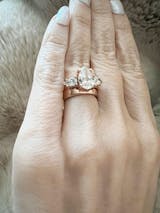
Who doesn't love a good love story? And we love when our customers share their love stories with us about the moment SHE SAID YES!
“After 12 years I am finally marrying my best friend!” says Liz Kearney, a Boston-based designer who shared her happy news with us on our Instagram page -- as did Mike Black, a videographer and Liz’s fiance.

“I could not be happier to start this next chapter of our incredible journey with the love of my life,” Mike wrote, with a picture of the ring he slipped on her finger after popping the question: a rose gold peach sapphire engagement ring, exclusively designed by Rosados Box. Shop Our Collection of peach sapphire rings.
What a Peach
The color peach is symbolic in many cultures. The fruit actually originates in ancient China, where in the Taoist religion its color represents immortality. In ancient Greece, peaches in the home symbolized a happy marriage. In Japanese mythology, a ripe peach with a green leaf on its stem signified truth, as the coupling of heart and tongue. It is customary for brides in both China and Japan to carry peach blossoms. And in many cultures across the globe, the color peach has long been associated with optimism, youthfulness, joie de vie, good luck, abundance, and protection for its wearer from bad spirits.
What gives peach sapphire engagement rings their unique color?
Sapphires are composed of the mineral corundum and span the color spectrum, from brilliant blue to yellow, pink, and orange (red sapphires are better known as rubies).
Peach sapphires get their color from trace elements of chromium and iron, and are typically found in Madagascar, Tanzania, and Sri Lanka, which has produced among the rarest of peach-colored sapphires, the Padparadscha (Sanskrit for “lotus flower”).
Sapphires have for centuries adorned the vestments and digits of royalty, the rich and famous, and faithful lovers the world over. Their variety of colors and brilliance guarantee that no two sapphires are alike, which makes each of these gorgeous diamond-alternative engagement rings unique. And its durability (9.0 on the mohs scale of hardness) is second only to diamond, which allows it to stand up to daily wear and tear, unlike other gemstones that must be worn with greater care.
Rose gold: Put a blush on it!
In recent years, peach sapphires paired with rose gold have been trending heavily as a unique alternative to the traditional diamond engagement ring. Rose gold is an alloy of gold that contains a certain percentage of copper, which gives the metal a warm, feminine, blushing hue that is flattering on all skin tones and marries well with colored gemstones.
See for yourself how our pairings of peach sapphire with rose gold make a statement that’s uniquely yours. Take a look at our “Rachel,” which pairs an oval peach blush champagne sapphire in a diamond halo on a rose gold band; and “Cara,” which sets a raspberry peach sapphire in a double halo of diamonds on rose gold. (A halo setting is one in which the centerpiece gemstone is encircled by smaller or micro pavé diamonds or other faceted gemstones.) Learn more about unique cuts and shapes of gemstones.
Fun facts about peach:
- August is National Peach Month.
- The peach is one of the “Three Blessed Fruits” in Buddhism and symbolizes longevity.
- The Peach Blossom is the state flower of Delaware.
- The peach is the official fruit of the state of Georgia; and Georgia’s state capital, Atlanta, has 71 streets named “Peachtree.”
Fun facts about sapphire:
- Sapphire is the birthstone of September.
- Sapphires are composed of the mineral corundum and come in many colors, including black, as well as colorless. Blue is the most popular sapphire color. The gemstone’s wide variety of colors result from trace elements of different minerals such as iron, titanium and chromium. The only color sapphires are NOT is red (red corundum is better known as a ruby).
- In 1796, The French Emperor Napoleon gave his lover Josephine a blue sapphire and diamond engagement ring. In 2013, it was sold at auction to an anonymous buyer for $1.17 million.
- It is common to apply heat treatments to sapphires (and rubies) to improve color tone and saturation. This process does not affect their value.
- Synthetic sapphires are real sapphires. Sapphires made in the lab, as with other lab-grown gemstones, are chemically and physically indistinguishable from those found in nature. Synthetic sapphires and other lab-grown gemstones also have the added advantage of being 100% conflict free.
- The Gemological Institute of America has a wealth of information about how to evaluate and select the perfect sapphire for you.

































